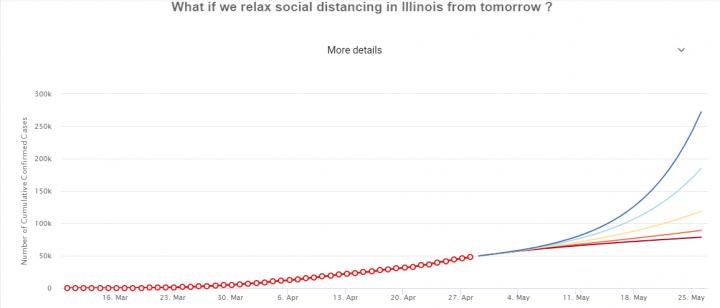Applying different social distancing policies to population statistics

Credit: Tarek Abdelzaher
Since the COVID-19 epidemic began, there has been plenty of opportunity to observe how a vast array of truths, half-truths, and falsehoods can flare up and spread like wildfire across social media, swirl around, and just as quickly get buried and forgotten. It could serve as a fascinating case study for CSL and computer science professor Tarek Abdelzaher, who for years has studied how information propagates through social media.
But he and his students Chaoqi Yang and Ruijie Wang have taken a big step further. They recognized that the dissemination of information through a population of online users is closely analogous to the transmission of a virus through a population of flesh-and-blood human beings, and that realization has inspired them to repurpose their information propagation models to predict COVID-19 spread. Furthermore, they have made the findings available to the public on an interactive website.
Abdelzaher says that the work is related to his DARPA SocialSim project, which kicked off in 2017 with the goal of developing simulation models for predicting information propagation cascades.
“Information, similarly to viral contagion, propagates through human contacts over ‘facilitating media’ that are a key construct in those models,” he explains. “For information cascades, a facilitating medium might be an online subreddit, a virtual hangout, or a Facebook wall. They constitute virtual spaces that allow information to spread. In the world of viral contagion, physical spaces, such as stores, offices, and homes, become the facilitating media.”
Abdelzaher, a Willett Faculty Scholar, points out that social distancing policies manipulate the availability of some of those “media.” As a result, within his team’s models, different social distancing policies can be applied to population statistics to predict the spread of COVID-19 in different nations or states.
Epidemiologists already have models for predicting infection spread, but the “SIR” models used in epidemiology–so-called because they predict the numbers of individuals in a population who will be “susceptible, infectious, or recovered” at a certain time–don’t inherently provide a way to adapt their predictions to different policies, such as social distancing, that would affect a disease’s spread. Initial results show that the new models from Abdelzaher’s team are more accurate than SIR models in predicting the impact to date of social distancing measures.
Abdelzaher, Yang, and Wang have launched an interactive website that anyone can visit to see predictions based on the most recent available data. They will continue to update it as their research progresses.
“There is currently mounting pressure to remove some [social distancing] restrictions for economic reasons,” notes Abdelzaher. The new website will allow people to see the consequences of adding, removing, or modifying social distancing rules. “Users will be able to interact to display curves for their country or state, as well as to ask ‘what if’ questions, like ‘what if social distancing was removed in my state from today onwards?’, or ‘what if X% of the impacted workforce were to go to back to work?’,” he says.
Abdelzaher hopes that the website will provide the public with a valuable source of insight that otherwise isn’t readily available. While numerous websites are providing up-to-date data on what has already happened, people don’t currently have a way to access the kind of predictive power that the new website offers.
“I think we can fill that gap with reasonably accurate results,” he says.
###
Media Contact
Allie Arp
[email protected]
Original Source
https:/




